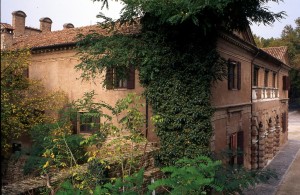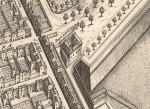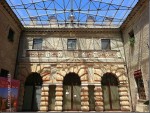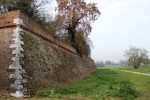Bagni Ducali and Montagnone
In 1541, Ercole II d’Este began construction on a small but delightful building to be used for leisure activities, right on the surface of the formidable Baluardo della Montagna. Here, after just a few years, art and nature became the focus of ducal splendour.
The Casin della Montagna: a ducal country home
The enormous artificial mound of earth known as the ‘Montagnone’ was created in the 1520s, when Duke Alfonso I d'Este decided to rebuild the entire south-eastern wall of the city, amassing all the land dug up while excavating the new ditches. Designed exclusively for military purposes, the hillock soon became one of the natural attractions within the Delizia della Montagna (House on the Mountain), the recreational residence built by Duke Ercole II d'Este on top of the bastion of the same name. It was constructed in early 1541 according to plans that were most likely drawn up by Terzo Terzi. The architect created a series of refined rooms arranged around a square courtyard with rustic porticoes on two sides. He also came up with a series of sophisticated hydraulic systems that drew water from the underlying entrenchments in order to satisfy the needs of the building and spaces above. The unique style of this small palace (a miniature of the Palazzo Te in Mantua) was enhanced by external façades, almost completely frescoed with images of people, landscapes and trompe l’oeil architecture by the best painters in Ercole’s court, especially Battista Dossi, Girolamo da Carpi, Camillo Filippi and Garofalo.
However, the residence was particularly known and admired for its unique setting, with waterways animated by complex hydraulic devices, flowing around a vine-and-flower-covered mountain, at the foot of which stood a fish pool measuring over 200 metres in length (now Viale Alfonso I d'Este). In summer, Duke Ercole loved to spend extended periods of time atop the colossal mound of earth, under the shade of a specially-arranged canopy near a man-made pool (built in 1546) measuring 7 m long and 4 m wide. Amid underground brooks and channels, water flowed impetuously along the slope, feeding into the ‘trumpets of the emblems’ of the fountains, some of which included audio mechanisms.
On its interior, the mountain (honoured by Torquato Tasso among his Rhymes of Love) concealed two underground caves, based on a design by Girolamo da Carpi, built in 1545-1549 and decorated with sea shells, gold leaves, landscapes painted by Luca and Girardo d’Olanda and ornamental mirrors applied to the vaults and sides in the summer of 1574 to celebrate the visit of King Henry III of France. A boxwood labyrinth, enclosures with a lion and lioness (given to Ercole by Emmanuel Philibert of Savoy in 1552), ostriches, dwarf donkeys, monkeys and peacocks made the spaces absolutely spectacular. Unfortunately, it all was destroyed in the early seventeenth century under the rule of the Papal Legates.
Duke Ercole II d’Este is known to historians for having brought aesthetic values and beautiful landscapes to some points along the fortified walls of Ferrara, making them places of leisure and relaxation. In the Rotonda and the Montagna di Sotto, art and nature testified to the magnificence of the prince within a theatrical framework of deep political importance, and it is no accident that the devastating fury of the Pope's delegated rulers was unleashed upon these very locations, eager to visually eliminate all symbols of the power of the House of Este.
Destruction in the seventeenth century
Historian and scholar Marco Antonio Guarini described the Duke's residential complex on the mountain, just before its lethal destruction:
...delightful building and garden, called the Montagna di San Giorgio, in which, entering through the large door, which, at the aforementioned Via della Giara, creates a delightful perspective, reveals a large square that, on the right, is decorated by a beautiful structure built by Duke Ercole II, which contains quite noble rooms, a large bathroom, and on the outside is embellished by various paintings by Girolimino Carpi, and Benvenuto Tisio (aka Garofolo), where King Henry of France dined on his way back from Poland. A little further away is an aviary, that in bygone times held various native and foreign species of live birds. Moving down the road from the aforementioned door, when exiting the aforementioned square, one entered a thick forest of different plants, that, in the middle, had a spring surrounded by a labyrinth. To the right of the aforementioned woods, heading up the embankment from it, were some alcoves of carved stones with different flowers, and delicate plants such as roses, jasmine, Scotch broom and others accommodated in various manners.
To the left there was, as in the present, a large man-made mountain, with a beautiful grotto behind it. On the inside, the first entry was round in shape, with shells worked into grottoesque decorations, and even further beyond, one entered a small square room covered in mosaics, with paintings and rather charming golden arabesques. Outside the door to the grotto was a large square pool sculpted in the finest marble, like a spring, and all of the above is now neglected, and almost in shambles. The aforementioned mountain could be climbed and descended under large, shade-providing pergolas covered in different types of grapevines, and other fruit and vegetable plants. At the top was an average square defined by overhanging larch arbours with even more grapevines. From there, one had an admirable view not only of the city, but the countryside beyond. The aforementioned mountain was planted and wooded with random plants, and the part that faced the city to the west had a low vineyard of various grapes that went form the base to the peak. In the entry of the aforementioned large door to the left of the delizia was a large pergola made of larch wood held up by many columns, with iron arches, also covered in various types of grapevines. Lengthwise it went from the aforementioned large door to the Chiesa della Madonna, also called Chiesa della Porta di Sotto, where between the pergola and the aforementioned mountain was a large fish pool as long as the pergola, holding lots of different types of fish’.
Alberto Penna recorded his horror the day after the destruction:
At Portone della Giara, one no longer finds gardens, a labyrinth, an aviary, grottoes and springs as they have all been ruined, destroyed and levelled. One no longer can make out the fish pool, as it has been filled with manure and made equal to the ground. No more grapevines, no more pergolas, no orchards, having all been cut down and uprooted. All that remains as a relic are a bare mountain, if not inasmuch covered by thorns, and the small building mentioned above the right part of the entry, in no better shape, so much so that it seems a pigsty, a human habitation in that place destroyed by soldiers, who have lived there, and who still are quartered there.
Starting in the late eighteenth century, various sources make reference to the small building as the ‘Fabbrica del Bagno’ (Building with the Bathroom) or ‘Bagni Ducali’ (Ducal Baths), a name still in use, deriving from the presence of a bathroom dating back the days of Ercole d’Este. In 1799, French troops used the building as a military garrison and stable, later adapted to a ‘detention centre’ for those called to service. In the nineteenth century, the entire section within the eastern walls was set up as a public walkway, connecting Corso Giovecca with Porta di San Giorgio by means of a road, later named Viale Afonso I d’Este. At the end of the century, the small building was then adapted for use as a ‘coffee factory with warehouses’ and a house for the caretaker (Scafuri in the website bibliography).
In the early twentieth century, it was home to the Biagio Rossetti Elementary School, a use that remained unchanged until 1944, when many rooms of the Bagni Ducali were occupied by displaced citizens. The decay and poor state of care lasted until the 1970s, when the municipal administration decided to restore the sixteenth-century building.
Atop the small hill was a reservoir for the aqueduct, designed by Giacomo Duprà, who brought water from the springs of Castelfranco Emilia (57 km away) into the city in 1890.
A metal cross on a column to the right of the path indicates the place where Girolamo Savonuzzi was shot and killed along with Arturo Torboli one night in 1943 (Lottici).
Today, fairs are held during the feast day of S. George (23 April), including a large amusement park.
Bibliography
- Marco Antonio Guarini, Compendio Historico dell'origine, accrescimento e prerogative delle chiese e Luoghi Pij della Città e Diocesi di Ferrara, heredi di Vottorio Baldini, Ferrara 1621
- Alberto Penna, Descritione della porta di San Benedetto della città di Ferrara, Mattio Carodin, Padova 1671
- Renzo Renzi (a cura di), Ferrara, il Po, la Cattedrale, la Corte dalle origini al 1598, edizioni Alfa, Bologna 1969
- Bruno Zevi, Saper vedere l'urbanistica: Ferrara di Biagio Rossetti, la prima città moderna europea, Einaudi, Torino 1971
- Andrea Marchesi, Grotte, Montagne e fontane estensi. Natura artificiata nella Ferrara del Cinquecento, in Gianni Venturi, Francesco Ceccarelli (a cura di), Delizie in villa. Il giardino rinascimentale e i suoi committenti, Olschki, Firenze 2008
- Andrea Marchesi, Delizie d'archivio. Regesti e documenti per la storia delle residenze estensi nella Ferrara del Cinquecento, Tomo II, Dimore urbane, Le Immagini edizioni, Ferrara 2015
- Ferrara. Storia, vie e piazze entro le Mura, in Adriano Lottici (a cura di), “Quaderni UTEF” 2018
Sitography
- http://servizi.comune.fe.it/index.phtml?id=5533
- http://servizi.comune.fe.it/attach/artistife/docs/libro_passeggiando.pdf
- http://rivista.fondazionecarife.it/it/1999/10/item/300-giardini-e-verde-storico-a-ferrara
- http://rivista.fondazionecarife.it/it/component/k2/item/418-la-rinascita-del-giardino-che-non-c%C3%A8
- http://old.castelloestense.it/delizie/ita/approfondimenti/penna.html
Fototeca
Related Themes
Related Subjects
Compiling entity
- Assessorato alla Cultura e al Turismo, Comune di Ferrara
Author
- Stefania De Vincentis








